Role of Conflict Management and Coaching Techniques in Resolving Conflict
VerifiedAdded on 2023/01/04
|12
|2678
|89
AI Summary
This report discusses the role and importance of conflict management and coaching techniques in resolving conflicts and improving performance. It explores conflict types, stages of conflict, negative impacts of conflicts, conflict management strategies, coaching techniques, and the GROW framework.
Contribute Materials
Your contribution can guide someone’s learning journey. Share your
documents today.

Role of conflict management and coaching techniques in resolving conflict
situation and improving the performance of individuals
situation and improving the performance of individuals
Secure Best Marks with AI Grader
Need help grading? Try our AI Grader for instant feedback on your assignments.
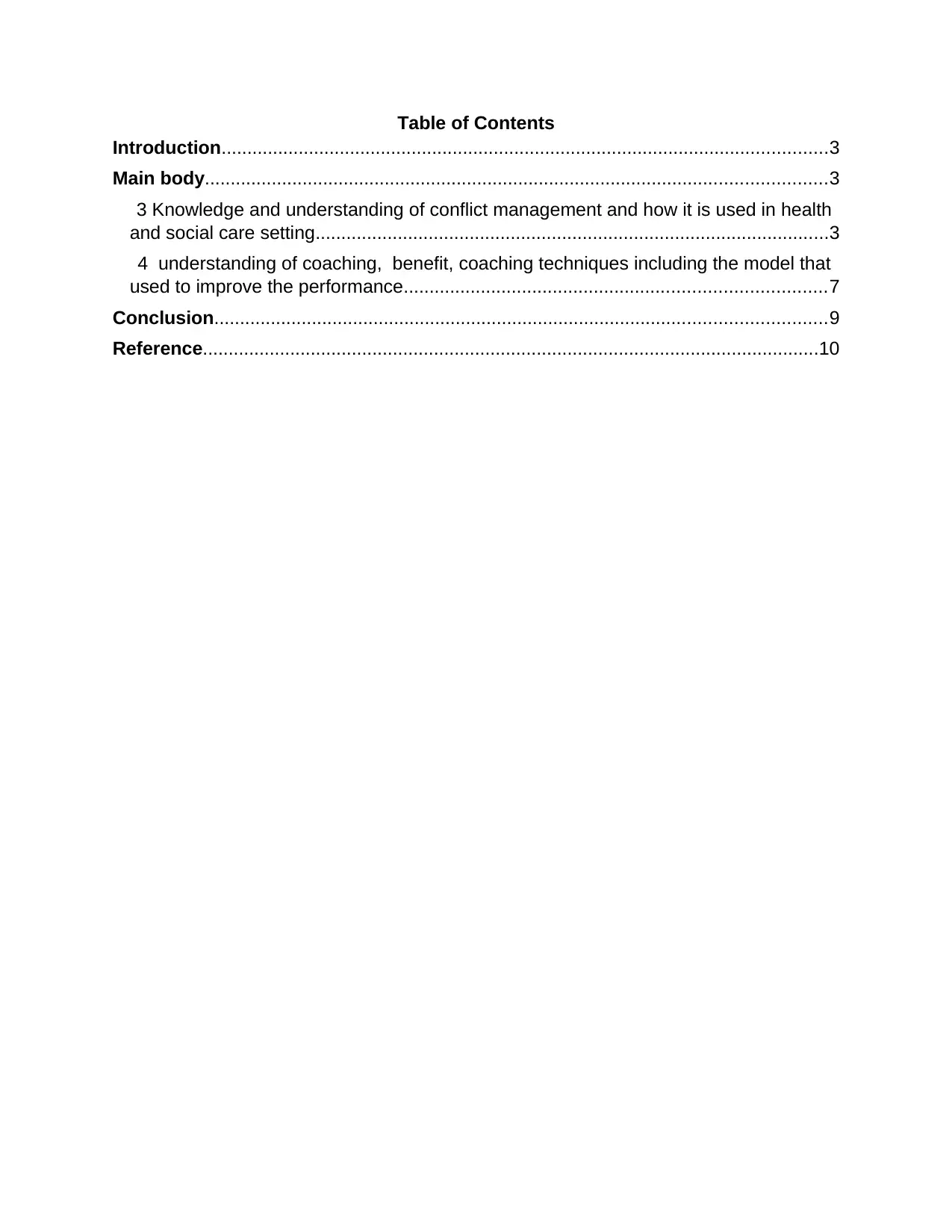
Table of Contents
Introduction......................................................................................................................3
Main body.........................................................................................................................3
3 Knowledge and understanding of conflict management and how it is used in health
and social care setting....................................................................................................3
4 understanding of coaching, benefit, coaching techniques including the model that
used to improve the performance..................................................................................7
Conclusion.......................................................................................................................9
Reference........................................................................................................................10
Introduction......................................................................................................................3
Main body.........................................................................................................................3
3 Knowledge and understanding of conflict management and how it is used in health
and social care setting....................................................................................................3
4 understanding of coaching, benefit, coaching techniques including the model that
used to improve the performance..................................................................................7
Conclusion.......................................................................................................................9
Reference........................................................................................................................10
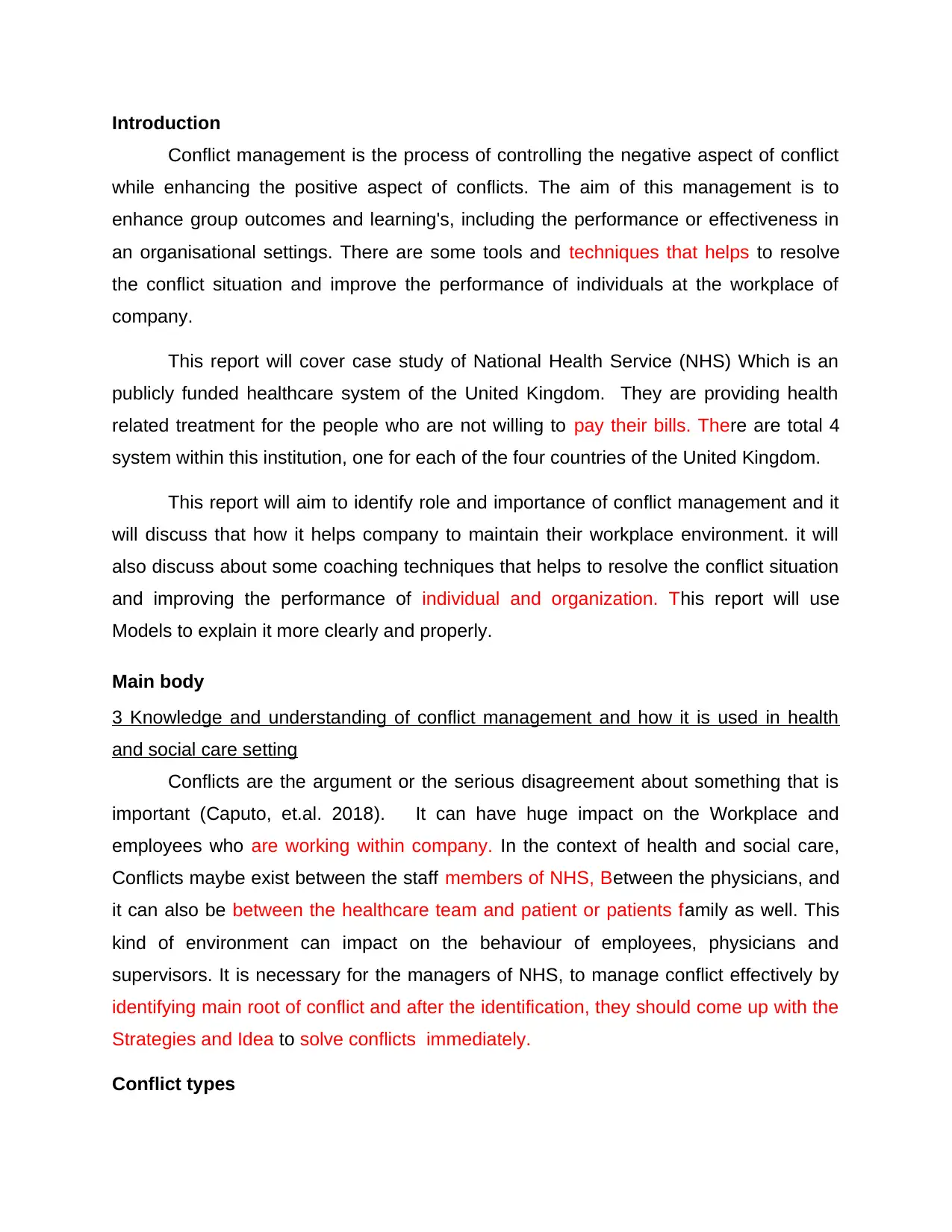
Introduction
Conflict management is the process of controlling the negative aspect of conflict
while enhancing the positive aspect of conflicts. The aim of this management is to
enhance group outcomes and learning's, including the performance or effectiveness in
an organisational settings. There are some tools and techniques that helps to resolve
the conflict situation and improve the performance of individuals at the workplace of
company.
This report will cover case study of National Health Service (NHS) Which is an
publicly funded healthcare system of the United Kingdom. They are providing health
related treatment for the people who are not willing to pay their bills. There are total 4
system within this institution, one for each of the four countries of the United Kingdom.
This report will aim to identify role and importance of conflict management and it
will discuss that how it helps company to maintain their workplace environment. it will
also discuss about some coaching techniques that helps to resolve the conflict situation
and improving the performance of individual and organization. This report will use
Models to explain it more clearly and properly.
Main body
3 Knowledge and understanding of conflict management and how it is used in health
and social care setting
Conflicts are the argument or the serious disagreement about something that is
important (Caputo, et.al. 2018). It can have huge impact on the Workplace and
employees who are working within company. In the context of health and social care,
Conflicts maybe exist between the staff members of NHS, Between the physicians, and
it can also be between the healthcare team and patient or patients family as well. This
kind of environment can impact on the behaviour of employees, physicians and
supervisors. It is necessary for the managers of NHS, to manage conflict effectively by
identifying main root of conflict and after the identification, they should come up with the
Strategies and Idea to solve conflicts immediately.
Conflict types
Conflict management is the process of controlling the negative aspect of conflict
while enhancing the positive aspect of conflicts. The aim of this management is to
enhance group outcomes and learning's, including the performance or effectiveness in
an organisational settings. There are some tools and techniques that helps to resolve
the conflict situation and improve the performance of individuals at the workplace of
company.
This report will cover case study of National Health Service (NHS) Which is an
publicly funded healthcare system of the United Kingdom. They are providing health
related treatment for the people who are not willing to pay their bills. There are total 4
system within this institution, one for each of the four countries of the United Kingdom.
This report will aim to identify role and importance of conflict management and it
will discuss that how it helps company to maintain their workplace environment. it will
also discuss about some coaching techniques that helps to resolve the conflict situation
and improving the performance of individual and organization. This report will use
Models to explain it more clearly and properly.
Main body
3 Knowledge and understanding of conflict management and how it is used in health
and social care setting
Conflicts are the argument or the serious disagreement about something that is
important (Caputo, et.al. 2018). It can have huge impact on the Workplace and
employees who are working within company. In the context of health and social care,
Conflicts maybe exist between the staff members of NHS, Between the physicians, and
it can also be between the healthcare team and patient or patients family as well. This
kind of environment can impact on the behaviour of employees, physicians and
supervisors. It is necessary for the managers of NHS, to manage conflict effectively by
identifying main root of conflict and after the identification, they should come up with the
Strategies and Idea to solve conflicts immediately.
Conflict types
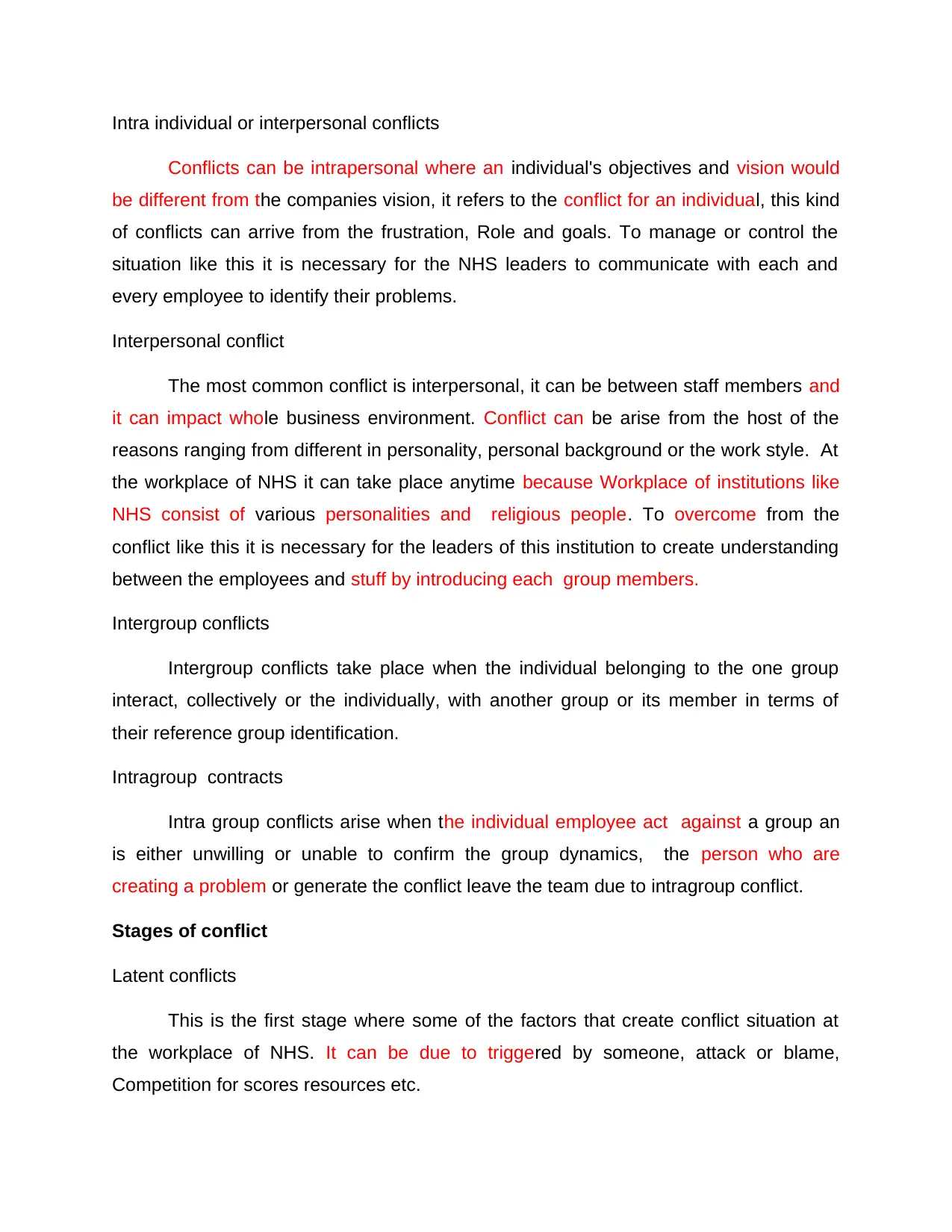
Intra individual or interpersonal conflicts
Conflicts can be intrapersonal where an individual's objectives and vision would
be different from the companies vision, it refers to the conflict for an individual, this kind
of conflicts can arrive from the frustration, Role and goals. To manage or control the
situation like this it is necessary for the NHS leaders to communicate with each and
every employee to identify their problems.
Interpersonal conflict
The most common conflict is interpersonal, it can be between staff members and
it can impact whole business environment. Conflict can be arise from the host of the
reasons ranging from different in personality, personal background or the work style. At
the workplace of NHS it can take place anytime because Workplace of institutions like
NHS consist of various personalities and religious people. To overcome from the
conflict like this it is necessary for the leaders of this institution to create understanding
between the employees and stuff by introducing each group members.
Intergroup conflicts
Intergroup conflicts take place when the individual belonging to the one group
interact, collectively or the individually, with another group or its member in terms of
their reference group identification.
Intragroup contracts
Intra group conflicts arise when the individual employee act against a group an
is either unwilling or unable to confirm the group dynamics, the person who are
creating a problem or generate the conflict leave the team due to intragroup conflict.
Stages of conflict
Latent conflicts
This is the first stage where some of the factors that create conflict situation at
the workplace of NHS. It can be due to triggered by someone, attack or blame,
Competition for scores resources etc.
Conflicts can be intrapersonal where an individual's objectives and vision would
be different from the companies vision, it refers to the conflict for an individual, this kind
of conflicts can arrive from the frustration, Role and goals. To manage or control the
situation like this it is necessary for the NHS leaders to communicate with each and
every employee to identify their problems.
Interpersonal conflict
The most common conflict is interpersonal, it can be between staff members and
it can impact whole business environment. Conflict can be arise from the host of the
reasons ranging from different in personality, personal background or the work style. At
the workplace of NHS it can take place anytime because Workplace of institutions like
NHS consist of various personalities and religious people. To overcome from the
conflict like this it is necessary for the leaders of this institution to create understanding
between the employees and stuff by introducing each group members.
Intergroup conflicts
Intergroup conflicts take place when the individual belonging to the one group
interact, collectively or the individually, with another group or its member in terms of
their reference group identification.
Intragroup contracts
Intra group conflicts arise when the individual employee act against a group an
is either unwilling or unable to confirm the group dynamics, the person who are
creating a problem or generate the conflict leave the team due to intragroup conflict.
Stages of conflict
Latent conflicts
This is the first stage where some of the factors that create conflict situation at
the workplace of NHS. It can be due to triggered by someone, attack or blame,
Competition for scores resources etc.
Secure Best Marks with AI Grader
Need help grading? Try our AI Grader for instant feedback on your assignments.
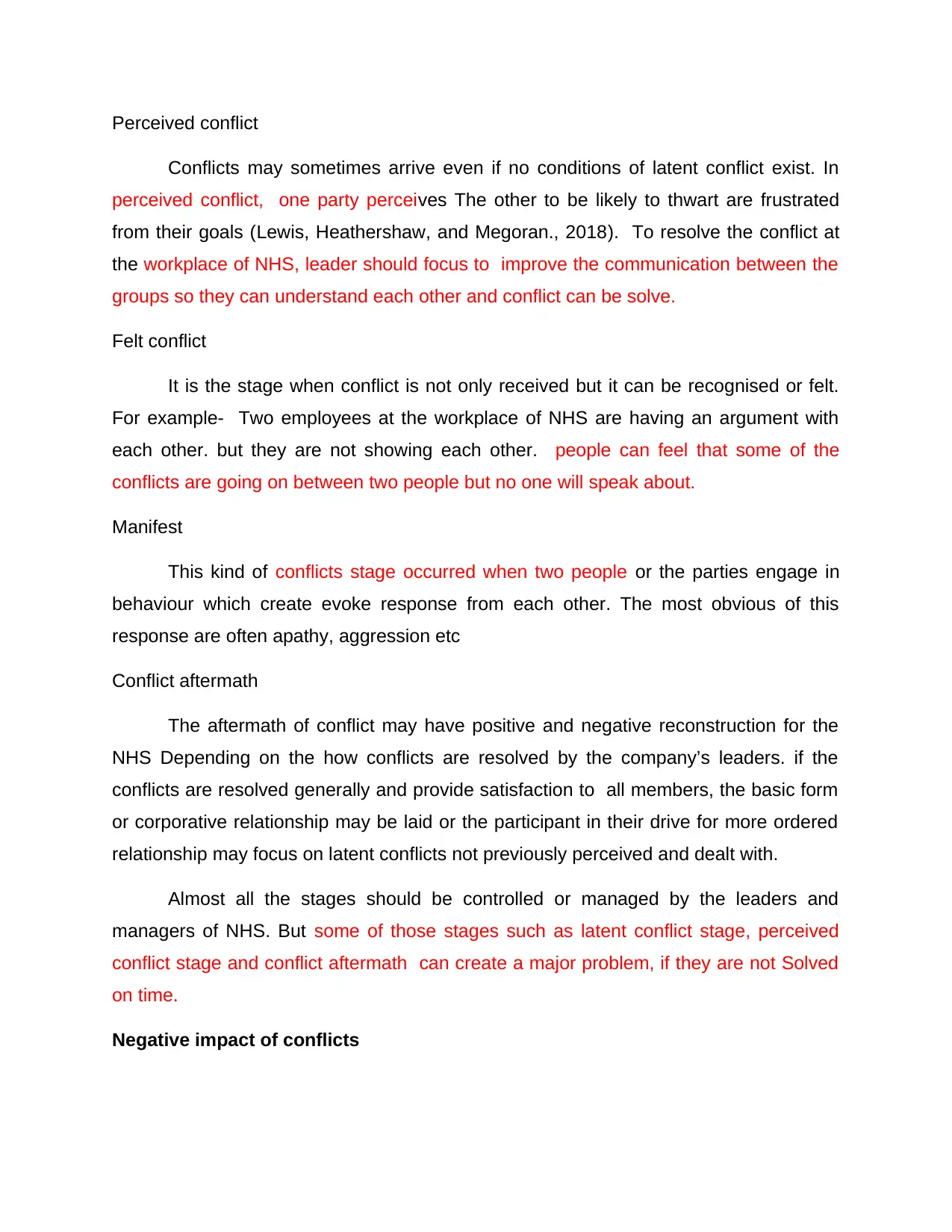
Perceived conflict
Conflicts may sometimes arrive even if no conditions of latent conflict exist. In
perceived conflict, one party perceives The other to be likely to thwart are frustrated
from their goals (Lewis, Heathershaw, and Megoran., 2018). To resolve the conflict at
the workplace of NHS, leader should focus to improve the communication between the
groups so they can understand each other and conflict can be solve.
Felt conflict
It is the stage when conflict is not only received but it can be recognised or felt.
For example- Two employees at the workplace of NHS are having an argument with
each other. but they are not showing each other. people can feel that some of the
conflicts are going on between two people but no one will speak about.
Manifest
This kind of conflicts stage occurred when two people or the parties engage in
behaviour which create evoke response from each other. The most obvious of this
response are often apathy, aggression etc
Conflict aftermath
The aftermath of conflict may have positive and negative reconstruction for the
NHS Depending on the how conflicts are resolved by the company’s leaders. if the
conflicts are resolved generally and provide satisfaction to all members, the basic form
or corporative relationship may be laid or the participant in their drive for more ordered
relationship may focus on latent conflicts not previously perceived and dealt with.
Almost all the stages should be controlled or managed by the leaders and
managers of NHS. But some of those stages such as latent conflict stage, perceived
conflict stage and conflict aftermath can create a major problem, if they are not Solved
on time.
Negative impact of conflicts
Conflicts may sometimes arrive even if no conditions of latent conflict exist. In
perceived conflict, one party perceives The other to be likely to thwart are frustrated
from their goals (Lewis, Heathershaw, and Megoran., 2018). To resolve the conflict at
the workplace of NHS, leader should focus to improve the communication between the
groups so they can understand each other and conflict can be solve.
Felt conflict
It is the stage when conflict is not only received but it can be recognised or felt.
For example- Two employees at the workplace of NHS are having an argument with
each other. but they are not showing each other. people can feel that some of the
conflicts are going on between two people but no one will speak about.
Manifest
This kind of conflicts stage occurred when two people or the parties engage in
behaviour which create evoke response from each other. The most obvious of this
response are often apathy, aggression etc
Conflict aftermath
The aftermath of conflict may have positive and negative reconstruction for the
NHS Depending on the how conflicts are resolved by the company’s leaders. if the
conflicts are resolved generally and provide satisfaction to all members, the basic form
or corporative relationship may be laid or the participant in their drive for more ordered
relationship may focus on latent conflicts not previously perceived and dealt with.
Almost all the stages should be controlled or managed by the leaders and
managers of NHS. But some of those stages such as latent conflict stage, perceived
conflict stage and conflict aftermath can create a major problem, if they are not Solved
on time.
Negative impact of conflicts

Conflict can create a huge problem for the institutions like NHS. It is one of the
biggest institution within the UK and having a good reputation in healthcare industry.
conflict management is important for the company because it can affect performance of
the employees , create bad workplace environment and it will also affect the patient
who came to take treatment.
Conflict management
Conflict management can be defined as reducing the negative impact and
outcomes of the conflict within the workplace. it helps to identify the conflicts that take
place and provide proper solution and decrease the negative impact of the conflict.
Conflict resolution techniques
There are some conflict resolution techniques that can be used by leaders and
managers of the NHS to overcome conflicts and they can manage workplace
environment effectively (McKibben. 2017). some of the best techniques are- listen, and
Speak out- It means that leaders and managers of the NHS should listen to the
employees about the problem they are facing and conflict reasons then they should
speak out. Gather the group- As a leader they should arrange the meeting that With the
invitation of the both parties Involved within the conflict. They can talk about the issues
both parties have with each other and try to resolve it within the meeting. promote
teamwork- teamworking can be another best conflict resolution technique that can be
used by leaders and managers of NHS.
Gibb’s reflective learning
Conflict situation can take place anytime and it can have disastrous effect on the
companies Workplace environment, it is necessary for the managers to be aware of
those situations so they can reduce the negative impact of conflicts among stakeholders
in the NHS (Wang, Zhang and Deng., 2019). Gibb’s model can be helpful to create
experiencing managers in resolving the conflict situation. It covered the six stages
Description
biggest institution within the UK and having a good reputation in healthcare industry.
conflict management is important for the company because it can affect performance of
the employees , create bad workplace environment and it will also affect the patient
who came to take treatment.
Conflict management
Conflict management can be defined as reducing the negative impact and
outcomes of the conflict within the workplace. it helps to identify the conflicts that take
place and provide proper solution and decrease the negative impact of the conflict.
Conflict resolution techniques
There are some conflict resolution techniques that can be used by leaders and
managers of the NHS to overcome conflicts and they can manage workplace
environment effectively (McKibben. 2017). some of the best techniques are- listen, and
Speak out- It means that leaders and managers of the NHS should listen to the
employees about the problem they are facing and conflict reasons then they should
speak out. Gather the group- As a leader they should arrange the meeting that With the
invitation of the both parties Involved within the conflict. They can talk about the issues
both parties have with each other and try to resolve it within the meeting. promote
teamwork- teamworking can be another best conflict resolution technique that can be
used by leaders and managers of NHS.
Gibb’s reflective learning
Conflict situation can take place anytime and it can have disastrous effect on the
companies Workplace environment, it is necessary for the managers to be aware of
those situations so they can reduce the negative impact of conflicts among stakeholders
in the NHS (Wang, Zhang and Deng., 2019). Gibb’s model can be helpful to create
experiencing managers in resolving the conflict situation. It covered the six stages
Description

This is the first stage where managers have to give description of their
experience about the conflict and they cover how it affect the workplace of NHS.
Feelings
It is the another step Managers look back on the situations and try to find out that
what employees think during the complex situations and what people think about it right
now.
Evolution
It is the stage where leader’s manage the value that what went well during the
Conflict situation and what was the contribution of manager in the conflict situation and
how they help institution to overcome.
Analyses
It is the same stage where manager of the NHS use their knowledge or learning
that they have experience from the previous conflict situation. They use list similar
techniques and strategies in future situation as well (Morselli and et.al. 2017).
Conclusion
It is the step where managers step back and look at themselves from a distance
and ask what else they could have done in this situation like conflict. The information
collected by them previously used here and take them toward the conclusion.
4 understanding of coaching, benefit, coaching techniques including the model that
used to improve the performance
Coaching and monitoring
Coaching and monitoring are two different terms, coaching means partnering
with the client in a true provoking a creating a process that inspired them an maximum
their personal and professional potential. It helped them to grow within the things they
are trying to learn and coaches are already a professional who are helping them to learn
effectively and give proper guidance when they are needed (Kanu., 2019).On the other
side monitoring or mentor is an experienced and trust advice within the business
experience about the conflict and they cover how it affect the workplace of NHS.
Feelings
It is the another step Managers look back on the situations and try to find out that
what employees think during the complex situations and what people think about it right
now.
Evolution
It is the stage where leader’s manage the value that what went well during the
Conflict situation and what was the contribution of manager in the conflict situation and
how they help institution to overcome.
Analyses
It is the same stage where manager of the NHS use their knowledge or learning
that they have experience from the previous conflict situation. They use list similar
techniques and strategies in future situation as well (Morselli and et.al. 2017).
Conclusion
It is the step where managers step back and look at themselves from a distance
and ask what else they could have done in this situation like conflict. The information
collected by them previously used here and take them toward the conclusion.
4 understanding of coaching, benefit, coaching techniques including the model that
used to improve the performance
Coaching and monitoring
Coaching and monitoring are two different terms, coaching means partnering
with the client in a true provoking a creating a process that inspired them an maximum
their personal and professional potential. It helped them to grow within the things they
are trying to learn and coaches are already a professional who are helping them to learn
effectively and give proper guidance when they are needed (Kanu., 2019).On the other
side monitoring or mentor is an experienced and trust advice within the business
Paraphrase This Document
Need a fresh take? Get an instant paraphrase of this document with our AI Paraphraser
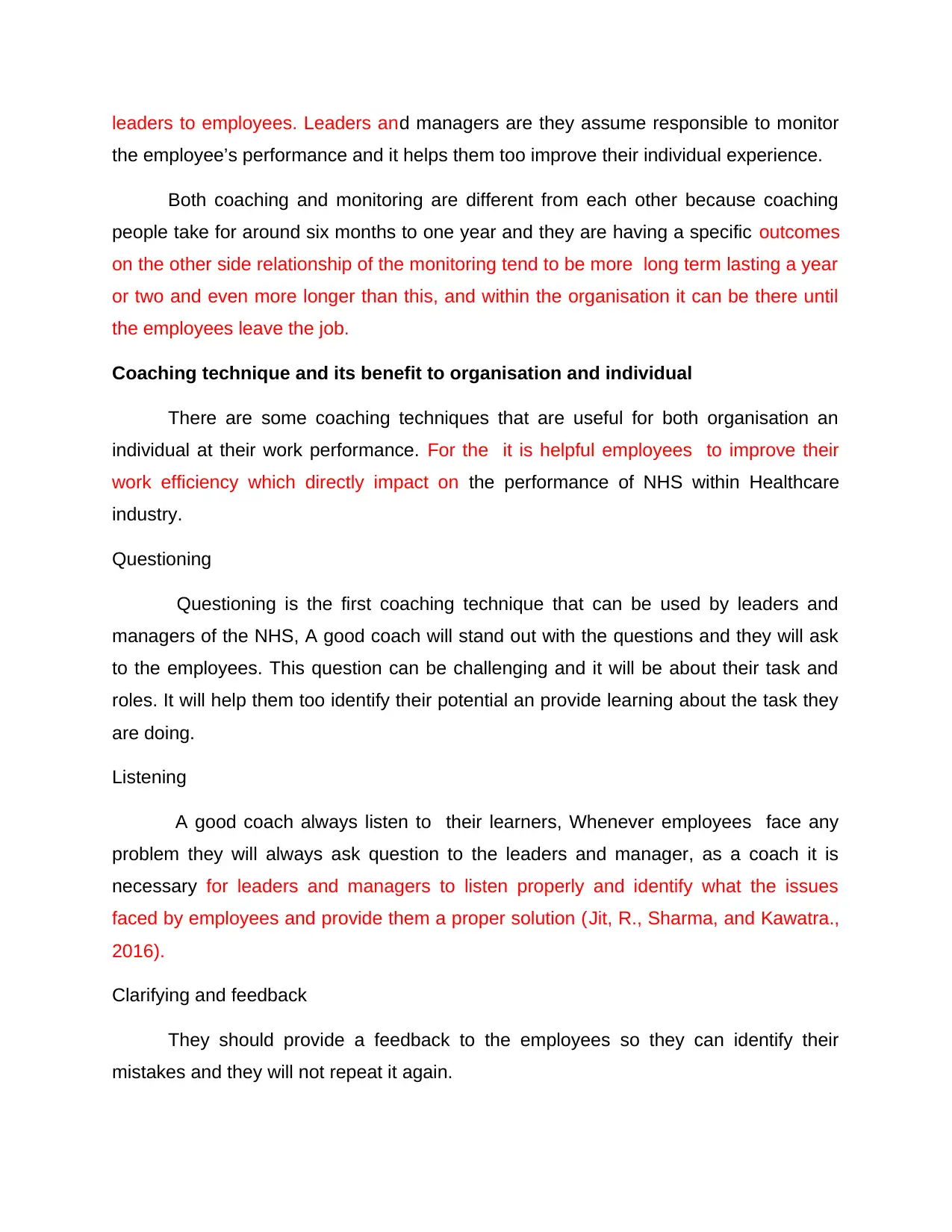
leaders to employees. Leaders and managers are they assume responsible to monitor
the employee’s performance and it helps them too improve their individual experience.
Both coaching and monitoring are different from each other because coaching
people take for around six months to one year and they are having a specific outcomes
on the other side relationship of the monitoring tend to be more long term lasting a year
or two and even more longer than this, and within the organisation it can be there until
the employees leave the job.
Coaching technique and its benefit to organisation and individual
There are some coaching techniques that are useful for both organisation an
individual at their work performance. For the it is helpful employees to improve their
work efficiency which directly impact on the performance of NHS within Healthcare
industry.
Questioning
Questioning is the first coaching technique that can be used by leaders and
managers of the NHS, A good coach will stand out with the questions and they will ask
to the employees. This question can be challenging and it will be about their task and
roles. It will help them too identify their potential an provide learning about the task they
are doing.
Listening
A good coach always listen to their learners, Whenever employees face any
problem they will always ask question to the leaders and manager, as a coach it is
necessary for leaders and managers to listen properly and identify what the issues
faced by employees and provide them a proper solution (Jit, R., Sharma, and Kawatra.,
2016).
Clarifying and feedback
They should provide a feedback to the employees so they can identify their
mistakes and they will not repeat it again.
the employee’s performance and it helps them too improve their individual experience.
Both coaching and monitoring are different from each other because coaching
people take for around six months to one year and they are having a specific outcomes
on the other side relationship of the monitoring tend to be more long term lasting a year
or two and even more longer than this, and within the organisation it can be there until
the employees leave the job.
Coaching technique and its benefit to organisation and individual
There are some coaching techniques that are useful for both organisation an
individual at their work performance. For the it is helpful employees to improve their
work efficiency which directly impact on the performance of NHS within Healthcare
industry.
Questioning
Questioning is the first coaching technique that can be used by leaders and
managers of the NHS, A good coach will stand out with the questions and they will ask
to the employees. This question can be challenging and it will be about their task and
roles. It will help them too identify their potential an provide learning about the task they
are doing.
Listening
A good coach always listen to their learners, Whenever employees face any
problem they will always ask question to the leaders and manager, as a coach it is
necessary for leaders and managers to listen properly and identify what the issues
faced by employees and provide them a proper solution (Jit, R., Sharma, and Kawatra.,
2016).
Clarifying and feedback
They should provide a feedback to the employees so they can identify their
mistakes and they will not repeat it again.

Benefits to the organisation and individual
The coaching technique will have huge benefits to the staff members of the NHS
and institution itself. Employees will able to improve their work performance and that will
enable them to provide better a good treatment to the patients. Patient who will get a
better treatment, which will improve their health and they can feel better and good
progress. It will directly impact on the NHS because they are responsible to maintain the
health of the society and if their employees are giving best in their task than it will
directly improve their organisational performance as well.
GROW framework
Goal
It is the stage where coaches try to find their focus on the daily goals and they
give periodic advice at the important moments. Coaching can be more better through
the creation of goals for the learner (Kurdek., 1995). Similarly, NHS Leaders and
managers can also create a long term goals and short term goals for the employees
that can give a clear picture of objectives they need to achieve.
Reality
It is the stage where coaches meet with the reality that how employees are
Performing and their progress to achieving the goals is going. They identify the
Progress and if it is not going well then they make a strategies. Leaders and managers
of NHS Should also measure their goals and process.
Option
It is the stage that allow clients to explore the possibilities and to choose which of
the possibilities will work the best to move them forward. When the client are able to
develop these options we are more motivated an imaginary concern to them. It is
necessary for the NHS employees to be aware of possibility that can help them to
motivate.
Way forward
The coaching technique will have huge benefits to the staff members of the NHS
and institution itself. Employees will able to improve their work performance and that will
enable them to provide better a good treatment to the patients. Patient who will get a
better treatment, which will improve their health and they can feel better and good
progress. It will directly impact on the NHS because they are responsible to maintain the
health of the society and if their employees are giving best in their task than it will
directly improve their organisational performance as well.
GROW framework
Goal
It is the stage where coaches try to find their focus on the daily goals and they
give periodic advice at the important moments. Coaching can be more better through
the creation of goals for the learner (Kurdek., 1995). Similarly, NHS Leaders and
managers can also create a long term goals and short term goals for the employees
that can give a clear picture of objectives they need to achieve.
Reality
It is the stage where coaches meet with the reality that how employees are
Performing and their progress to achieving the goals is going. They identify the
Progress and if it is not going well then they make a strategies. Leaders and managers
of NHS Should also measure their goals and process.
Option
It is the stage that allow clients to explore the possibilities and to choose which of
the possibilities will work the best to move them forward. When the client are able to
develop these options we are more motivated an imaginary concern to them. It is
necessary for the NHS employees to be aware of possibility that can help them to
motivate.
Way forward
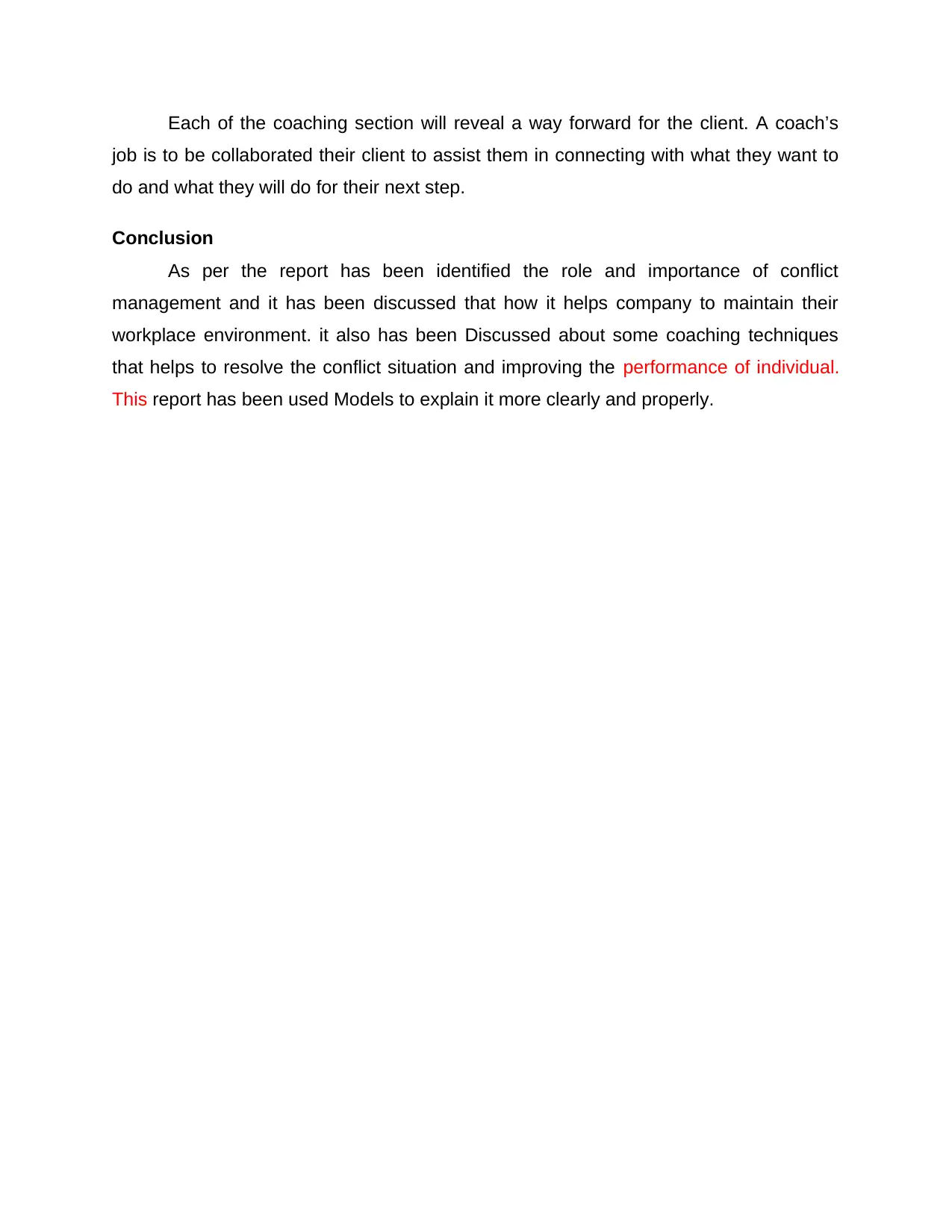
Each of the coaching section will reveal a way forward for the client. A coach’s
job is to be collaborated their client to assist them in connecting with what they want to
do and what they will do for their next step.
Conclusion
As per the report has been identified the role and importance of conflict
management and it has been discussed that how it helps company to maintain their
workplace environment. it also has been Discussed about some coaching techniques
that helps to resolve the conflict situation and improving the performance of individual.
This report has been used Models to explain it more clearly and properly.
job is to be collaborated their client to assist them in connecting with what they want to
do and what they will do for their next step.
Conclusion
As per the report has been identified the role and importance of conflict
management and it has been discussed that how it helps company to maintain their
workplace environment. it also has been Discussed about some coaching techniques
that helps to resolve the conflict situation and improving the performance of individual.
This report has been used Models to explain it more clearly and properly.
Secure Best Marks with AI Grader
Need help grading? Try our AI Grader for instant feedback on your assignments.
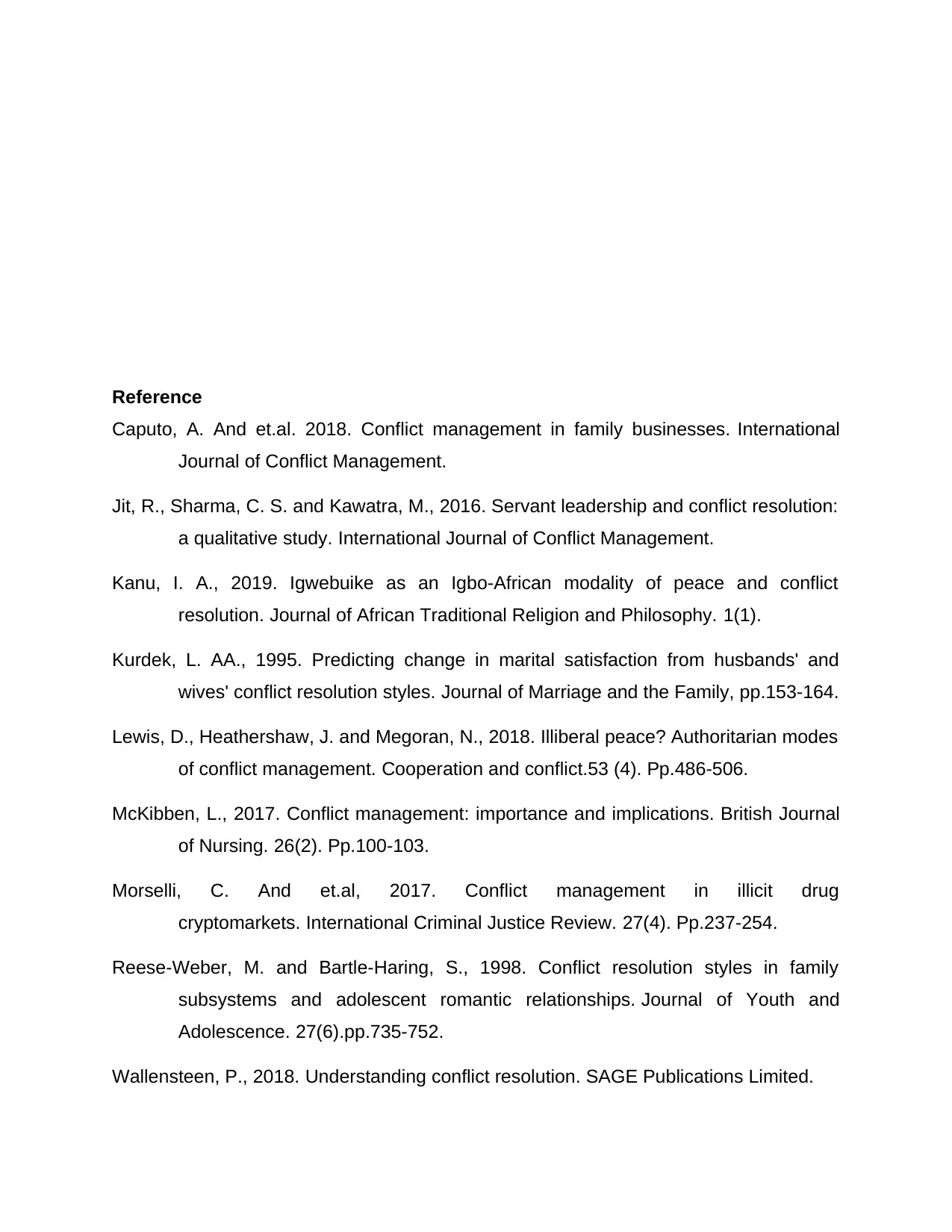
Reference
Caputo, A. And et.al. 2018. Conflict management in family businesses. International
Journal of Conflict Management.
Jit, R., Sharma, C. S. and Kawatra, M., 2016. Servant leadership and conflict resolution:
a qualitative study. International Journal of Conflict Management.
Kanu, I. A., 2019. Igwebuike as an Igbo-African modality of peace and conflict
resolution. Journal of African Traditional Religion and Philosophy. 1(1).
Kurdek, L. AA., 1995. Predicting change in marital satisfaction from husbands' and
wives' conflict resolution styles. Journal of Marriage and the Family, pp.153-164.
Lewis, D., Heathershaw, J. and Megoran, N., 2018. Illiberal peace? Authoritarian modes
of conflict management. Cooperation and conflict.53 (4). Pp.486-506.
McKibben, L., 2017. Conflict management: importance and implications. British Journal
of Nursing. 26(2). Pp.100-103.
Morselli, C. And et.al, 2017. Conflict management in illicit drug
cryptomarkets. International Criminal Justice Review. 27(4). Pp.237-254.
Reese-Weber, M. and Bartle-Haring, S., 1998. Conflict resolution styles in family
subsystems and adolescent romantic relationships. Journal of Youth and
Adolescence. 27(6).pp.735-752.
Wallensteen, P., 2018. Understanding conflict resolution. SAGE Publications Limited.
Caputo, A. And et.al. 2018. Conflict management in family businesses. International
Journal of Conflict Management.
Jit, R., Sharma, C. S. and Kawatra, M., 2016. Servant leadership and conflict resolution:
a qualitative study. International Journal of Conflict Management.
Kanu, I. A., 2019. Igwebuike as an Igbo-African modality of peace and conflict
resolution. Journal of African Traditional Religion and Philosophy. 1(1).
Kurdek, L. AA., 1995. Predicting change in marital satisfaction from husbands' and
wives' conflict resolution styles. Journal of Marriage and the Family, pp.153-164.
Lewis, D., Heathershaw, J. and Megoran, N., 2018. Illiberal peace? Authoritarian modes
of conflict management. Cooperation and conflict.53 (4). Pp.486-506.
McKibben, L., 2017. Conflict management: importance and implications. British Journal
of Nursing. 26(2). Pp.100-103.
Morselli, C. And et.al, 2017. Conflict management in illicit drug
cryptomarkets. International Criminal Justice Review. 27(4). Pp.237-254.
Reese-Weber, M. and Bartle-Haring, S., 1998. Conflict resolution styles in family
subsystems and adolescent romantic relationships. Journal of Youth and
Adolescence. 27(6).pp.735-752.
Wallensteen, P., 2018. Understanding conflict resolution. SAGE Publications Limited.

Wang, Y., Zhang, K. and Deng, Y., 2019. Base belief function: An efficient method of
conflict management. Journal of Ambient Intelligence and Humanized
Computing. 10(9). Pp.3427-3437.
conflict management. Journal of Ambient Intelligence and Humanized
Computing. 10(9). Pp.3427-3437.
1 out of 12
Related Documents
Your All-in-One AI-Powered Toolkit for Academic Success.
+13062052269
info@desklib.com
Available 24*7 on WhatsApp / Email
![[object Object]](/_next/static/media/star-bottom.7253800d.svg)
Unlock your academic potential
© 2024 | Zucol Services PVT LTD | All rights reserved.





